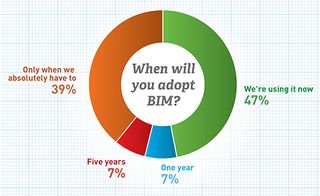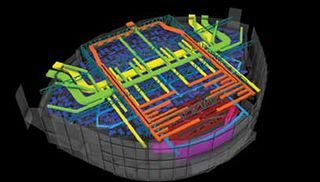BIM. It may be the elephant in your room. If your first inclination is to turn this page or look away, better not. BIM (Building Information Modeling) is coming to a project near you. Even if you have not chosen to invest in BIM as of yet, this is a good time to educate yourself on exactly what it brings to the table, and to plot the trajectory of any future involvement.
“The adoption of BIM represents an irrefutable tide of technology, and any person within the AV value chain who ignores it does so at their own risk,” said David Labuskes, the recently named executive director and CEO of InfoComm International.
Labuskes is a former vice president of RTKL (a division of Arcadis), the global architecture, engineering, planning, and creative services organization where he established its Technology Design Studio. “I’m not a great champion of BIM for our industry,” he admitted, “but it’s like fighting a white tide; we don’t have a choice. Like it or not, get in.”
Plunging into BIM comes with associated price tags both in financial costs and in time and training to help employees develop the necessary skill sets. There are additional costs related to converting existing AutoCAD libraries in order to use BIM effectively.
The costs should be carefully considered by integrators, said Jay Paul, vice president of quality control for AVI-SPL. “I can’t speak to the motivations of other integrators, but yes, there is both a cost and learning curve, and I would assume that anyone considering adoption of BIM will carefully weigh potential return on investment.”
To date, AVI-SPL has had few projects that require them to work in BIM. “There is no inherent advantage to doing so if the project does not require it,” he added. “We have a substantial investment in AutoCAD with a few hundred installed seats, a mature library of blocks, and a workforce comfortable with the software and our standards.
That BIM has come to the forefront for AV integrators by way of consultants and from other design disciplines may help to explain its somewhat slow adoption. “I think it was developed specifically to assist the MEP (mechanical, electrical, and plumbing) guys do their jobs better when it comes to routing all their stuff through the building and creating a bill of materials,” said Steve Emspak, partner with Shen Milsom & Wilke. “It also has allowed building management to better understand what is in the walls.”
>>> SCN Online Survey Vote on a new survey online today at avnetwork.com.

BIM’s value to several different parts of the built environment comes in different degrees, Labuskes said. “For architects and engineers it’s an extraordinary tool. In fact, structural engineers were using tools like this early on in order to release early steel packages and for other functions.”
As it now exists, BIM provides extra value for general contractors and engineers, he added, “As you move more deeply into designing the detailed aspects of building, it becomes more of a challenge to eke out value from the tool. Everyone has different definitions of BIM utilizations. It requires a layer of administration and control. This may become easier as users’ BIM skills improve. “
Casey Sherred, senior consultant at Acoustic Dimensions, participated in the InfoComm Task Force on BIM. The group was tasked with creating best practices for BIM content development along with standard parameters to describe AV equipment and a parameter list user guide.
Close to 70 percent of AD’s projects involve BIM and the number continues to rise each year, he said. “The primary benefits include improved coordination and a better understanding of design concepts with a shared understanding of issues. We still use AutoCAD for schematics and panel details linked into Revit for sheet management.”
As consultants, Sherred explained, AD’s use of BIM is being driven by architects and owners who are demanding BIM. “Basically, if you’re not in BIM you’re not on the job. The demand is not as big for integrators, but it will be. A number of the larger general contracting firms, which hold AV contracts, will require integrators to use BIM. They want to make sure there won’t be coordination issues in a project’s future.”
AD has invested a lot of time and money in BIM, he explained. “There’s an outlay of financial cost, but the biggest cost is in the steep learning curve. Architects are willing to give up 30-year relationships with MEP firms because they don’t use BIM. Federal, state, and local government projects are requiring BIM for building projects. The state of Wisconsin specifically requires AV and communication systems to be completed using BIM software.”
Take the BIM Challenge
Any new revolutionary technology comes with challenges, and BIM is no exception, Labuskes acknowledged. “One challenge I had with it at RTKL came in trying to use it as a new tool to produce the same documentation we had previously created in CAD; you can’t do that. This is probably the way many new users try to implement BIM, but you have to throw away preconceptions and the way you have been doing documentation in order to enable BIM’s promise. It’s important to recognize that it is a database and not a drawing package.”
Emspak believes many of the larger projects BIM (and IPD) have become a standard rather than the exception. “BIM, as is the case with 3D modeling in almost any form, can readily assist the experienced user in avoiding problems that may otherwise negatively impact the final outcome,” he said. “Or, in the extreme, make an unworkable solution workable.”
For example, for locating a projector and addressing sight line issues, planning conduit routing through an incredibly tight ceiling plenum (the interstitial space above the finished ceiling over an operating room floor with a huge quantity of very large air ducts, piping for gases, and all kinds of mechanical and plumbing), or providing clearances for servicing equipment, one can readily see the BIM values, Emspak added.
Potential conflicts certainly can be identified in the BIM model rather than in the field, but every discipline in a project has to be using BIM the same way and in the same time in order to reach the same point of completion, Labuskes explained. “But that’s not the way design happens; not everything flows in a parallel. Much of what the AV industry does has to be delayed two to three years behind architectural and structural engineering design. For example, a switcher proposed in 2013 may not be procured until 2015. You can leave allowances for this in BIM projects.

Close to 70 percent of Acoustic Dimensions’ projects involve BIM, and the number continues to rise each year.Consultants need to have their eyes wide open, he cautioned, and integrators need to learn as much as quickly as they can to incorporate these tools and develop efficiencies. “BIM has the ability of resolving clashes prior to the 11th hour in field, but doesn’t eliminate them. What it does is move resolution to an earlier stage in the project because you won’t have to tear out and rebuild.”
Although even small projects are being facilitated with BIM—AD is currently designing a BIM project for a 500-seat chapel—complexity may be more of a factor than square footage.
“Complexity tends to drive the need in my opinion,” Emspak said. “And I’m not so sure that the value lies in having every possible widget available as a BIM Family. As an example, developing a detail for an equipment rack that has every component highly articulated does not provide much value other than a wow factor. But having that rack model available to ensure that it fits where it is supposed to be elicits another discussion.”
Even with its learning curve, the advantages of BIM are palpable. “Giving someone any particular tool and sending them off into the wilderness does not in any way ensure success,” Emspak noted. “Success is generally rooted in experience. Now, giving an experienced person an advanced tool such as modeling can yield extraordinary results.”
The bottom line about BIM, Sherred said, is that it’s “about capturing information, not only to produce traditional deliverables but also to leverage that data including costs, energy usage and utilization, owner’s manuals, and warranty information throughout the building lifecycle. You can walk around a facility with the model on an iPad allowing you to see through the walls.
“The longer you wait, the harder it will be to distinguish yourself in the market place without BIM,” he concluded. “Start now and you’re further ahead.”
Karen Mitchell is a freelance writer living in Boulder, CO.
What’s Driving BIM
Chuck Wilson is the first to acknowledge that at least one of his 2012 predictions has not come to pass.
“I expected that by now, integrators would be immersed in BIM,” said Wilson, executive director at NSCA. “It isn’t coming as quickly to the system integration community as I thought it would. What we see so far is that is that they haven’t been required to provide anything other than aesthetic information with BIM, such as placing a device on a wall; they haven’t been fully integrated into the BIM process. I think most will wait until they are forced to do something because of a requirement on a specific job.”
Noticeable, rather, are new success stories centered on projects from the engineering and architectural communities (such as the Construction Specifications Institute) where BIM is an essential ingredient. What this means, he explained, is that NSCA members have not yet reached a level that requires them to purchase BIM utilization software. NSCA’s surveys show that most members are aware of it but haven’t been forced to adopt it in 3D modeling.
“What we do see is that BIM is most effective for end users as a way to show a facility being built to prospective sponsors and advertisers, possibly for naming rights,” Wilson said. “An example is the multi-purpose Barclays Center in Brooklyn which hosts the Brooklyn Nets. 3D images were captured and used to find sponsors. The twist is to capture a venue on BIM, put it on an iPad, and walk into a Fortune 500 company and say, ‘Wouldn’t you want your name to be here?’”
Wilson noted that the integration industry didn’t immediately realize that 3D modeling would also be a sales tool to promote it. “Once an architectural firm becomes fully versed in BIM software it will be scalable in projects of any size as a way to do things from now on for every job on the design board,” he said. “3D modeling is a growing trend, and designers will want to present this view of a building back to the owner to be able to execute changes on an electronic format, not a drawing board.”
—K.M.
BIM Reality Check
The risk/reward that comes with adopting any new technology is often difficult to measure. With BIM, the uncertainty increases ten-fold. Will the time and energy dedicated to learning a complex, expensive computer program truly pay dividends? And is now really the time to do this? Or can it wait a decade.
While many integrators have been putting off the decision to go BIM, manufacturers haven’t had this luxury due to the high rate of adoption in other fields. So who have they seen using BIM? And on which kinds of projects?
Draper, which adopted BIM in 2008 and is in the process of expanding its BIM library to cover all of its products, sees consultants using the technology far more than integrators. “Consultants are using Revit and that is still growing,” said Steve Cook, Draper’s national AV consultant manager. “There are some projects where the architect mandates that all participants be up on Revit so they can bring their files right into the master Revit file that the architect keeps. So for AV, the consultants are the ones working with the architect on the AV design.”
Middle Atlantic has released three different generations of models since it adopted BIM in 2009, and is seeing the Revit platform and AutoCAD used on many large projects. “Typically, the architect determines that the project will be designed in this way, and requires all of the disciplines to utilize this platform,” explained Michael Cukrow, technical marketing manager for Middle Atlantic. “This makes the design stage more time consuming and more costly, but significantly increases the potential for the project to be executed both on time and on budget, which significantly outweighs the additional costs of designing in Revit.”
Video Mount Products president Keith Fulmer agreed with this assessment, referring to BIM as a virtual 5D platform “enhancing the three primary spatial dimensions, and adding time and cost as the fourth and fifth.” This is especially useful on large projects like convention centers where there are almost an immeasurable number of moving pieces.
What types of projects are using BIM? According to John Loufik, senior applications engineer at Community Professional Loudspeakers, the larger the project, the more likely it will use BIM. “Those we have seen ranged from sports complexes to TV studios.”
While the benefit to the manufacturer is clear—consultants may not use their products in projects if they don’t have Revit family files for them—what benefits can integrators expect to reap from adopting the technology? Aside from the project management benefits, Fulmer sees it as a way for small firms to stand out in a crowd, impress their clients, and drive repeat business. “If you show up to meet with clients, say a town council, and have 3D models instead of paper blueprints? That client will be impressed, and will never go back to the person with blueprints.”
That wow factor may not be enough to convince small firms to get on board. “Smaller firms are avoiding BIM as much as they can because of the high cost to enter the game,” said Loufik. “For now, that’s working since architects have been protective of their intellectual property and don’t share the model with companies that are a couple of steps removed from the core design team. This delay is also giving everyone a chance to deal with other financial stresses (recession) before diving into expensive software and training.”
—Chuck Ansbacher











